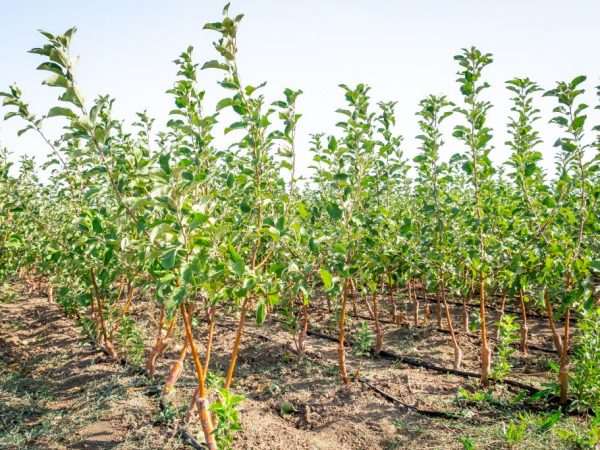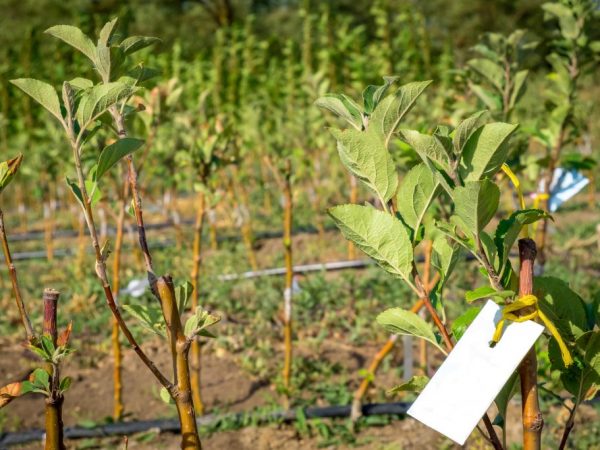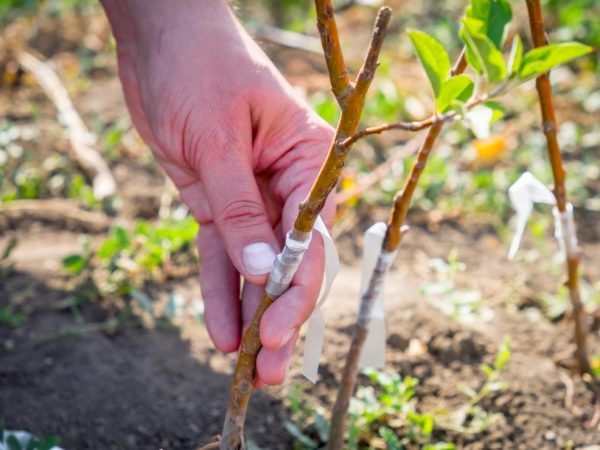Autumn apple transplant - when to carry out the procedure
Often, gardeners are forced to transplant apple trees to another place. There are many reasons: crown growth, unfavorable location, strong deepening of the root collar, sending the seedling for sale. Consider how to carry out the procedure in the fall, and what time frame should you adhere to?

Autumn apple transplant - when to carry out the procedure
The purpose of the autumn transplant
The best time to move culture to a new site is autumn.
In this season, the tree prepares for hibernation, the metabolic processes in the internal tissues slow down, as a result, the susceptibility to stress decreases.
Most often, the apple tree has to be transplanted for the following reasons:
- the initially selected place is unfavorable, soil conditions, level of illumination, protection from winds do not correspond to the norm;
- the root collar is badly worn out;
- the crown has grown, there is not enough space for it;
- the seedling is being prepared for sale;
- the plant is affected by a disease, to get rid of which a transplant is required.
Optimal timing
A transplant in the fall is more favorable than in the spring, however, for the correct procedure, it is important to take into account certain nuances.
The optimal time is from the second half of September to mid-October.
By this time, the leaves have fallen off, the harvest is harvested. The apple tree enters the phase of preparation for winter sleep: despite the slowdown in metabolism, the root system is still quite active - it recovers without difficulty until the air temperature drops below 4 ° C.
Thanks to the still warm soil, it is easier for the plant to adapt to new conditions, to restore the marginal roots, which are important for absorbing nutrition and moisture.
It is impossible to delay the procedure. It must be carried out at least 2 weeks before the arrival of frost. Otherwise, the tree will have difficulty getting through the winter.
Transplant rules
Young apple trees
It is best to replant an apple tree 2-3 years old in the fall.
She is already strong enough to survive the transfer to a new place without negative consequences. And at the same time, it is not yet so large that the gardener cannot cope with the work on his own.
The transplanting of young seedlings is carried out by the transshipment method. The first step is to choose a site with optimal conditions: it is well lit by the sun and protected from the winds. It is advisable to choose a more elevated corner of the garden.
If you plan to transplant a tree before dropping the foliage, then you need to cut the crown. Such a measure will allow the plant to save energy on recovery and begin the regeneration of the root system.
It is better to mark the root collar on the trunk, so as not to be mistaken with the deepening of the tree in a new place.
A month before the transplant, a hole is dug - the diameter is made up to 2 m, the depth is no more than 0.5 m.

Apple trees need sunshine
Prepare it: lay out drainage, apply fertilizers, cover it with a fertile substrate so that it has time to settle.
If the groundwater on the site is located above 1.5 m from the surface of the earth, then drainage is required, otherwise there is a high probability of root decay. Crushed stone is usually used.
The type of feeding and dosage depends on climatic and soil conditions, as well as age.
- They take manure (only rotted, not fresh), sawdust, ash, compost, sand, all this is mixed.
- Of the mineral compositions, ammonium nitrate, potassium, urea are suitable.
If the soil on the site is peaty, poor in nutrient content, acidic, a neutralizer is required - lime or chalk.
Algorithm of actions:
- the plant is dug out carefully so as not to damage the roots (when setting the diameter of the trench around the trunk, you should be guided by the fact that the width of the root system approximately corresponds to the size of the crown);
- the seedling is pulled out with a lump of soil, carefully wrapped in a cloth, transferred to the planting hole;
- at the bottom, at some distance from the central point, a supporting stake is driven in;
- a cone-shaped mound of fertile soil is made on top of the fertilizer layer, an apple tree is placed on it, the roots are carefully straightened so that they do not bend up;
- the seedling is watered abundantly, the trunk is tied to the stake;
- the hole is covered with a substrate, tamped;
- the soil around the trunk is mulched with straw or sawdust.
Old apple trees
It is more difficult to replant an adult apple tree because its root system is developed and widely spread in the ground. If the plant is large, spreading, then its width can reach 10-15 m.
Digging it out of the ground is problematic, but it is weakly susceptible to stress.
It is necessary to relocate by transshipment, but the problem is that its weight is very solid, you will have to take assistants.
In the extracted tree, the roots protruding beyond the soil lump are cut off. The sections are disinfected. Side shoots are tied to the trunk for convenience.
The planting algorithm is the same as for a young seedling:
- dug a planting hole in advance according to the volume of the root system, prepare it;
- at the bottom, thick supporting stakes are driven in at the edges;
- the apple tree is placed in the hole, the trunk is tied to the supports;
- fall asleep with fertile soil;
- watered, sawdust is used as mulch.
The specificity of the transplant is that crown pruning is a mandatory step. If it is not carried out, then there is a high probability of death of shoots and a decrease in yield.
The procedure makes the culture more resistant to insect pests and unfavorable climatic conditions, strengthens its immunity.
It is carried out in October, when the tree has shed its leaves, prepared for hibernation, the metabolism slowed down in the wood.
It is extremely important to be in time before frost, since it takes about 2 weeks for a culture to recover, heal sections. If the deadlines are not met, there is a high probability of problems with the wood frame.
The pruning scheme is age appropriate.
- For seedlings up to 5 years old, a cut is made by a quarter of the length, strong shortening is unacceptable.
- After 5 years, a third of the shoot is cut off.
- Half of the old tree is removed.
- And centenarians are sure to undergo anti-aging pruning.
Garden pitch is applied to the slices, which promotes rapid healing. If young seedlings are easy to cut with pruning shears, then an adult apple tree can only be cut with a saw.
Columnar varieties

Columnar varieties age quickly
A feature of the varieties is a short fruiting period. An apple tree that has reached 5 years old is already old, it is replaced with a new one.
Planting algorithm is the same as for classic varieties. The crown of trees is compact, so when planting in a row, the distance between the trunks can be made 0.5 m.
Nuances to consider:
- landing hole size 0.5 × 0.5 m, depth 0.6 m;
- annual saplings tolerate stress better;
- it is unacceptable to transplant to a site with surface groundwater;
- the root collar should be at the level of 5 cm from the soil;
- the grafting point should face south;
- the layer of mulch should be thick, because columnar varieties have superficial roots.
Dwarf varieties
Autumn transplanting of dwarf trees is carried out at the end of September. The algorithm of the procedure is the same as for classic varieties.
The size of the planting hole is 0.7 × 0.7 m, the depth is 0.5 m. The root system is superficial, this must be taken into account when mulching and watering, but the depth of the groundwater does not matter.
Follow-up care
A transplanted apple tree, especially an old one, requires special care, which will allow it to quickly take root in a new place.
Experienced gardeners advise:
- water the plant often;
- do not dig up the soil in the first season after transplanting;
- carry out mulching with peat and humus;
- before the arrival of winter, wrap the trunk with artificial insulation or spruce paws;
- prune branches in spring to speed up their development;
- remove flower buds in the first spring after transplanting.
What to do if the roots are damaged
The survival rate of an apple tree depends on the state of the root system.
If the main rods are healthy, then the second-order roots extending from them quickly regenerate. Therefore, taking it out of the soil, the injured roots are removed, a garden pitch and an antiseptic preparation are applied to the sections.
If one of the leading rods is injured, conducting nutrients to the trunk, then the damaged area is treated with an antiseptic, covered with pitch.
In order for the root to recover faster, the branches are cut - this increases the chance of its survival.
Regional features
The timing and method are determined by the climatic and soil conditions in the region where the garden plot is located.
Moscow suburbs
Terms - September-October. Soil temperature should not be lower than 8 ° C.
Gardeners living in the Moscow region take into account the depth of groundwater.
- If the distance between groundwater and the soil surface is significant, then the tree can be transplanted anywhere.
- If it is less than 1.5 m, and there are no hills on the site, then a hill must be poured at the landing site.
Middle lane and northwest
The optimal time for transplanting in the middle lane is September and early October. In the northwestern regions, it is carried out earlier - until the end of August.
Gardeners in the northwestern regions prefer to plant apple trees in the fall, because the climatic conditions this season are humid, which has a positive effect on root recovery.
Since the deep soil layers here are cold, poor in nutrients, the root system grows mainly in width.
Siberia
Transplanting trees in the fall is problematic for Siberians. It is highly likely that the culture will not survive the cold.
But if the gardener decided to take a chance, then it is permissible only to dig in young trees for the winter. The hill is prepared, and after the spring thawing of the soil, the seedlings are transplanted to another place.
Summing up
Autumn is a favorable period for transplanting young and adult apple trees. The main thing is to comply with the terms and agrotechnical rules, taking into account the climatic characteristics of the region, age, variety and condition of the tree. And then it will quickly recover, henceforth it will delight with a bountiful harvest.

